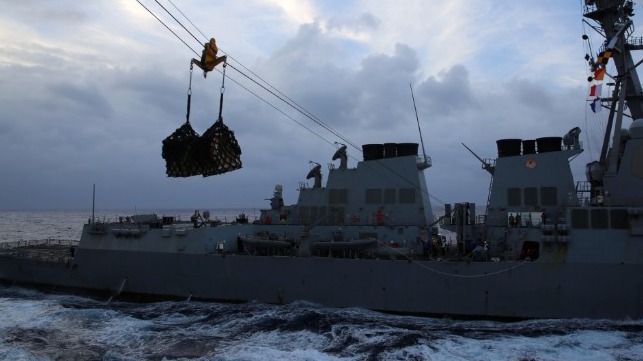Rebuilding a Navy That Is Self-Sufficient at Sea

[By Anthony Cowden]
My recommendations to the next Chief of Naval Operations are based on the difference between the kind of navy we have today and the kind of navy our nation needs. Today we have a forward-based navy, not an expeditionary navy. This distinction is important for remaining competitive against modern threats and guiding force design.
Due to the unique geographical position of the U.S., the Navy has the luxury of defending the nation’s interests “over there.” Since World War II, it developed and maintained a navy that was able to project power overseas; to reconstitute its combat power while still at sea or at least far from national shores; and continuously maintain proximity to competitors. This expeditionary character minimized the dependence of the fleet on shore-based and homeland-based infrastructure to sustain operations, allowing the fleet to be more logistically self-sufficient at sea.
However, late in the Cold War, the U.S. Navy started to diminish its expeditionary capability, and became more reliant on allied and friendly bases. A key development was subtle but consequential – the vertical launch system (VLS) for the surface fleet’s primary anti-air, anti-submarine, and land-attack weapons. While a very capable system, reloading VLS at sea was problematic and soon abandoned. While an aircraft carrier can be rearmed at sea, surface warships cannot, which constrains the ability of carrier strike groups to sustain forward operations without taking frequent trips back to fixed infrastructure. The Navy is revisiting the issue of reloading VLS at sea, and those efforts should be reinforced.
The next step the Navy took away from an expeditionary capability was in the 1990s, when it decommissioned most of the submarine tenders (AS), all of the repair ships (AR), and destroyer tenders (AD), and moved away from Sailor-manned Shore Intermediate Maintenance Centers (SIMA). Not only did this eliminate the ability to conduct intermediate maintenance “over there,” but it destroyed the progression of apprentice-to-journeyman-to-master technician that made the U.S. Navy Sailor one of the premier maintenance resources in the military world. Combat search and rescue, salvage, and battle damage repair are other areas in which the U.S. Navy no longer has sufficient capability for sustaining expeditionary operations.
 The U.S. Navy destroyer tender USS Yellowstone (AD-41) underway on 1 September 1981. (U.S. Navy photo)
The U.S. Navy destroyer tender USS Yellowstone (AD-41) underway on 1 September 1981. (U.S. Navy photo)
The Navy needs a new strategy that highlights the kind of fleet the nation needs. This strategy would argue the Navy needs to be able to use the sea when needed, to deny it to the nation’s enemies, and to project force ashore when required. To accomplish this, the Navy would maintain a tempo of operations using the necessary multi-domain forces, wherever in the world they are required. The Navy’s operations and force posture should always be based on the logic that naval operations will principally be conducted “over there,” far from the nation’s borders, and with a minimum of dependence on shore-based infrastructure.
The Navy also needs a different overall force structure to return to a more balanced and expeditionary force. The modern fleet is top-heavy in large surface combatants, light in smaller combatants, and insufficient in auxiliary ships. In summary, a new force structure calls for:
- 11 Aircraft carriers
- 10 LHA/LHDs
- 21 Amphibious warfare ships
- 71 Large surface combatants
- 78 Small surface combatants
- 66 Attack submarines
- 12 Ballistic missile submarines
- 34 Combat logistics forces
- 48 Support vessels
This overall battle force of 351 ships is a more balanced and affordable force structure than what is currently under consideration.
The top thing the next CNO can do to affordably improve the U.S. Navy as a fighting force is to reduce operational tempo. Returning to predictable six-month-long deployments would improve force material readiness, morale, and retention. The tempo necessarily increased after 9/11 and the war in Iraq, but those efforts are largely over and the Navy needs to return to a rational and sustainable level of effort. The Navy will be able to make numerous and far-reaching changes to its warfighting readiness and expeditionary capability if it can manage to create a stable foundation of predictable deployment cycles.
Anthony Cowden is the Managing Director of Stari Consulting Services, co-author of Fighting the Fleet: Operational Art and Modern Fleet Combat, author of The Naval Institute Almanac of the U.S. Navy, and was a commissioned officer in the U.S. Navy for 37 years.
The opinions expressed herein are the author's and not necessarily those of The Maritime Executive.
